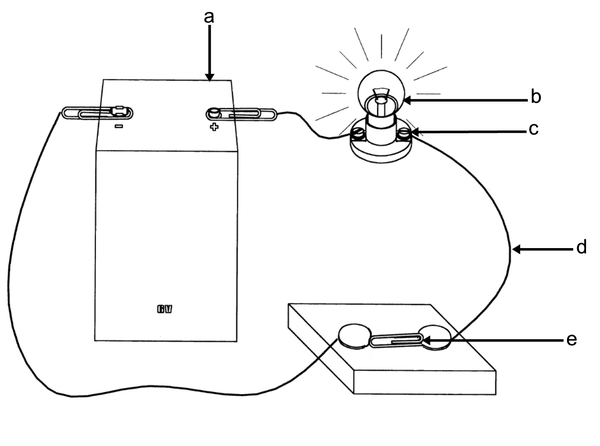| << Chapter < Page | Chapter >> Page > |
There are two main types of electricity: mainstream electricity and battery electricity .
Create a poster showing electrical implements that work with mainstream electricity a
and with battery electricity.

Chemical energy is electrical energy that is trapped in the chemicals inside a battery, which therefore has the potential to generate an electrical current. In a wet cell battery, two metal strips that are referred to as electrodes and are of copper and zinc are placed in an acid solution named an electrolyte. A chemical reaction occurs and this creates electrical power. Negative electrons flow through the acid solution from the copper to the zinc. The current returns to the copper via the wire and this is how the electricity flows. The chemical energy stored inside the battery is measured in VOLT. We have batteries with varying strengths, each with a negative and a positive pole.

The first battery was made in 1790, by the Italian Allessandro Volta.
Current always flows from a positive pole to a negative pole in an electrical circuit. The electrical current therefore is created when electrons move in one direction along a length of wire. To provide electrical energy, the electrons need to move in an uninterrupted circuit, the electrical circuit . The only way in which it is possible to see whether there is a flow of electricity, is to observe its effect.
What are the basic elements of an electrical circuit?

Assignment 5B

Isolators are materials that do not conduct electricity, e.g. plastic, rubber and glass. It is used to cover metal wires or light bulb sockets to prevent the current from flowing through other metal objects that may come into contact with it.
A specific symbol is used for each element of the electrical circuit and this is useful when a circuit is represented in a circuit diagram .
| ELEMENT | SYMBOL | ||
| A battery | |||
| A conductor | |||
| A sliding switch | |||
| A light bulb | |||
| A LED | |||
| Direction of the current |
Examine the following rules for how to take care when you use mainstream electricity to determine whether the statements are TRUE or FALSE . First do it individually and then discuss it with the rest of the group members.
| INDIVIDUAL | GROUP | |
|
||
|
||
| 3. Do not pull a plug out of a wall socket by the electric cord, especially while the switch is on. | ||
|
||
|
||
|
||
|
Assessment
Learning Outcomes(LOs)
LO 1
TECHNOLOGICAL PROCESSES AND SKILLS
The learner will be able to apply technological processes and skills ethically and responsibly using appropriate information and communication technologies.
Assessment Standards(ASs)
We know this when the learner:
1.9 works efficiently and safely;
1.13 chooses and uses appropriate technologies to present, record or communicate technological and/or scientific processes followed (e.g. simple portfolio, posters, charts, models, scientific investigations).
LO 2
TECHNOLOGICAL KNOWLEDGE AND UNDERSTANDING
The learner will be able to understand and apply relevant technological knowledge ethically and responsibly.
We know this when the learner:
2.4 demonstrates knowledge and understanding of the components of simple electrical circuits (e.g. connecting wires, battery, switch, output device), and how electrical energy can be converted into other forms (e.g. light, heat, sound, movement).

Notification Switch
Would you like to follow the 'Technology grade 6' conversation and receive update notifications?